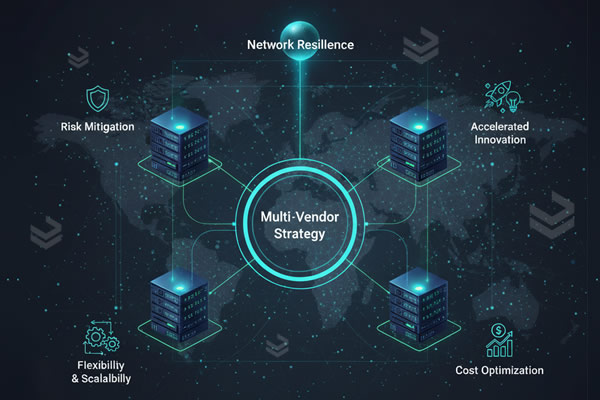The latest news and insights

The Strategic Advantage of a Multi-Vendor Approach in Telecommunications
In today’s rapidly evolving telecommunications landscape, adopting a multi-vendor strategy has become a foundational pillar for operators and service providers aiming to enhance network resilience, optimize costs, and accelerate innovation.
Risk Mitigation and Supply Chain Resilience
Relying on a single vendor introduces concentration risk, potentially impacting network stability, project delivery, and operational continuity if issues arise with that vendor. A multi-vendor architecture offers built-in redundancy and strategic flexibility, reducing dependency on any one supplier and mitigating risks related to supply chain disruptions, vendor insolvency, or technical incompatibilities. This resilience is vital for maintaining service availability and meeting stringent SLA requirements in dynamic market conditions.
Flexibility and Scalability
Telecom networks must quickly adapt to changing traffic patterns, technology upgrades, and evolving service demands. By decoupling network functions across different best-of-breed providers, a multi-vendor environment enables operators to tailor their networks to specific business objectives. It also offers scalability advantages by allowing seamless expansion and efficient resource allocation across vendors with complementary capabilities, empowering operators to evolve at their own pace without being locked into a single ecosystem.
Cost Optimization and Competitive Procurement
Vendor diversification fosters competitive vendor management, offering opportunities for negotiating improved pricing, flexible contract terms, and better support models. This dynamic procurement environment incentivizes innovation and performance, allowing operators to achieve a more balanced total cost of ownership (TCO). By avoiding vendor lock-in, they can optimize both capital and operational expenditure across the network lifecycle.
Accelerated Innovation and Technology Access
Working with multiple vendors provides access to a wider range of cutting-edge technologies and specialized services. It fuels an innovation ecosystem where telecom operators can deploy emerging technologies faster, experiment with novel network architectures, and benefit from multiple innovation pipelines. This multi-source approach supports agile network evolution aligned with 5G, cloud-native, and software-defined networking trends, enabling future-ready deployments that adapt as market needs evolve.
Summa Networks: Enabling Multi-Vendor Excellence
At Summa Networks, we recognize that the future of telecommunications depends on modular, interoperable, and risk-mitigated network infrastructures. Our solutions are designed from the ground up to be vendor-agnostic and cloud-native, enabling operators to build and evolve their networks with freedom and confidence.
By combining our vendor-agnostic design with deep expertise in interoperability, Summa Networks empowers operators to evolve their networks with confidence and independence. Through this approach, we help telecom operators deploy flexible, future-proof infrastructures that deliver superior performance, cost-efficiency, and innovation velocity — all critical to thriving in an increasingly competitive and technology-driven market.
Latest Blog

Empowering Operators with Summa Networks' Multi Vendor Core Mobile Solutions


